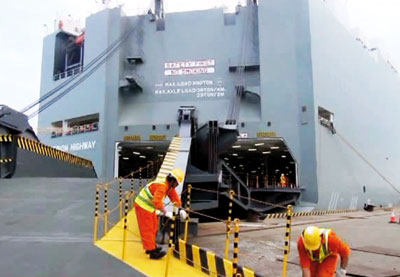Borrowing realities: I borrow, you pay
View(s):The Government debt level is in excess of Rs. 9,387 billion, according to a report in the Sunday Times on January 21. The government is moving to bring in a Liability Management Law to manage public debt. Managing debt does not mean that we don’t have to pay it back; neither does it mean a reduction in debt level. Rather debt management means that “we are getting ready” to repay our previous borrowings but in a “manageable” manner.
Therefore we should not be surprised when the date of settling a loan installment is placed on our doorstep one relaxed and leisurely morning as you have breakfast. However, to get ready in advance we still have to borrow because we are already in the state of borrowing further to repay previous borrowings.
Size of the public debt
Before that, however I must clarify how big our debt problem is. As we usually speak of in millions and billions of rupees, we do not get a sense of the size of our debt. In fact, when the figure is more than six digits, many have a problem in grasping its size.
Sri Lanka’s outstanding debt is nearly 80 per cent of GDP as of 2016, compared to 250 per cent in Japan. But it does not mean at all that Sri Lanka’s debt problem is less serious than Japan’s because it depends not on the size of the debt but the ability pay it. Government debt has to be paid from tax revenue so that the annual debt repayment should be manageable with the tax revenue collection while taking care of all other government expenditure.
According to the Budget Speech 2018, last year the government’s total revenue was Rs. 1,989 billion, while total expenditure without interest payments was Rs. 1,952 billion. However the government has also paid Rs.1,575 billion (interest plus amortisation). This means that the total government expenditure including debt service was Rs. 3527 billion. How did we do that? Since there is no magic, it can be done only by borrowing further.
Investing in Ceylon Railway
The question that I would like to analyse today is why has Sri Lanka plunged into such a public debt problem? I may not bring out all possible reasons including reckless borrowing tendencies and their alleged corruptions.
Rather my focus is more on the economics of borrowings than any other issues related to borrowings.
Is borrowing bad? The answer depends on how do you intend to use it and how do you intend to pay it back. There is no difference in answers when the borrowing is carried out by a person or a family or a company or a nation.
Whoever borrows, the implications are the same. Let me take an interesting example from the Ceylon Railway history: Indrani Munasinghe, a former Professor of History at Colombo University, published a research study in 2002 titled, “The Colonial Economy on Track: Roads and Railways in Sri Lanka (1800-1905)”. The book provides a detailed account of the borrowing and investment by the then British government which commenced the first railway track in Sri Lanka between Colombo and Kandy in 1854. The analysis portrays the greater degree of responsibility and accountability of the British government when it undertook this mega investment in Ceylon Railway through borrowings.
The government had established the Ceylon Railway Company in 1945 to carry out investment in and operation of the railway. The first railway track from Colombo to Ambepussa was opened in 1865 and its second section to Polgahawela in 1866, and the entire railway to Kandy in 1867.
It is worthwhile noting that even Japan commenced its first railway construction few years later than Sri Lanka also by British engineers; the first railway track of about 30 km between Tokyo and Yokohama was opened for traffic in 1872 – seven years after Sri Lanka opened the first railway service to Ambepussa from Colombo.
Borrowing, repaying the loan

File picture of a giant vessel at the Hambantota Port built with loans
By 1905, within 45 years after opening the first railway track to Ambepussa, the Ceylon Railway Company had completed 562 miles of railway lines in Sri Lanka, spending Rs. 71 million “original capital” as it is recorded in the research study. About 64 per cent of this investment came from commercial borrowings from the London capital market, while four per cent was from local borrowing. The balance 32 per cent was provided from the government budget while the government levied an export duty on export crops transported by railway to recover part of that.
The borrowings were based on the issuance of railway shares and debentures.
Even in the face of economic recession in Britain in the late 19th Century, holding of Ceylon’s railway shares and debentures were considered to be profitable and attractive to investors.
A special fund was created to collect money from the railway profits and export duties in order to repay the loans. As the railway was profitable enough to pay off its debt, the government was able to abolish the export duty in 1870. It was also reported that the total debt incurred for the Colombo-Kandy railway had been paid off completely by the Ceylon Railway Company by 1883, within 16 years after opening Colombo – Kandy railway track.
150 years later
Today, 150 years after the opening of the first loan-funded Colombo-Kandy railway line, we have a different system of borrowing and repaying: the governments borrow and the people pay.
If we had learnt from the British colonial past, the loan borrowed to construct the Hambantota Port would have been repaid by the income generated from the Port itself. The same principle applies to most of the government’s infrastructure projects such as international airports, conference facility, theatres, cricket stadiums, power plants, expressways and many others. Yet the loans are now pooled together as “public debt” and transferred to the government budget. It is not mandatory to assess the economic and financial viability of these projects because the loans are repaid by someone else; people and even their future generations. Therefore, the government has the ability to get away from its responsibility and accountability in respect of its borrowings.
In the absence of public sector and public enterprise reforms in the country, there exist other models too while these are no better than the above: One of them is the model that applies to public enterprises. Another that can be applied to many government agencies is the model that treats income and expenditure independent of each other. We might be able to talk on another day about these models and how people bear the burden of their existence.
Sri Lanka Railway is not an enterprise by its legal definition, but a “government department” in which income has nothing to do with its expenditure. The profits of the Ceylon Railway that were first used to pay off the loan for its investment and, then used to reinvest for railway expansion, turned out to be losses. According to the information from the Central Bank’s “Annual Report 2016″, an average Sri Lanka Railway passenger travelling one km pays less than 90 cents, while the operating cost of the Railway for that passenger (excluding capital cost) is Rs. 1.80. This means that for each passenger km the Sri Lanka Railway is charging only half its running cost, leaving aside the capital costs of trains, tracks, stations, and other expenses.
According to the loss and profits accounts of the Sri Lanka Railway, it is obviously unlikely to be in operation for long. Then how does it survive? It is because its losses and capital depreciation both are borne by the government budget or the tax revenue collected by the government.
I feel there is a bit missing here, if I do not say something about today’s Japan Railway which was established after the Ceylon Railway.
There are both government and private railways in Japan, while the fastest Shinkansen bullet train is managed by five groups of companies. It runs at the speed of over 300 km per hour competing well with domestic air travel as well. Japan is also in progress in bringing out within the next couple of years the fastest train in the world that can speed up to 600 km per hour.
(The writer of this weekly column in the Business Times dealing with economic issues is Professor of Economics at the Colombo University)


